ECU ENS6126 Master of Engineering Project 1 Progress Report
VerifiedAdded on 2023/03/20
|41
|9434
|55
Report
AI Summary
This report presents a Master of Engineering project focused on designing a wearable device for athlete position tracking. The project aims to fulfill the demand for real-time feedback in sports, utilizing technologies such as Magnetometer, IMU, and UWB for accurate player monitoring. The methodology involves integrating these technologies to create a single device capable of tracking player movements on the field. The report includes an introduction outlining the objectives and significance of the project, a review of existing sports tracking systems, and a proposed approach. The report also includes preliminary results and discussions, along with figures and tables illustrating the concepts and findings. The goal is to create an affordable, accurate, and user-friendly device that enhances athlete performance and minimizes injuries. The report also discusses the organization of the report and various sensors used in the technology, including GPS modules, accelerometers, gyroscopic sensors, and magnetometers. The project emphasizes the significance of combining these technologies for precise athlete tracking and real-time positioning for enhanced performance.
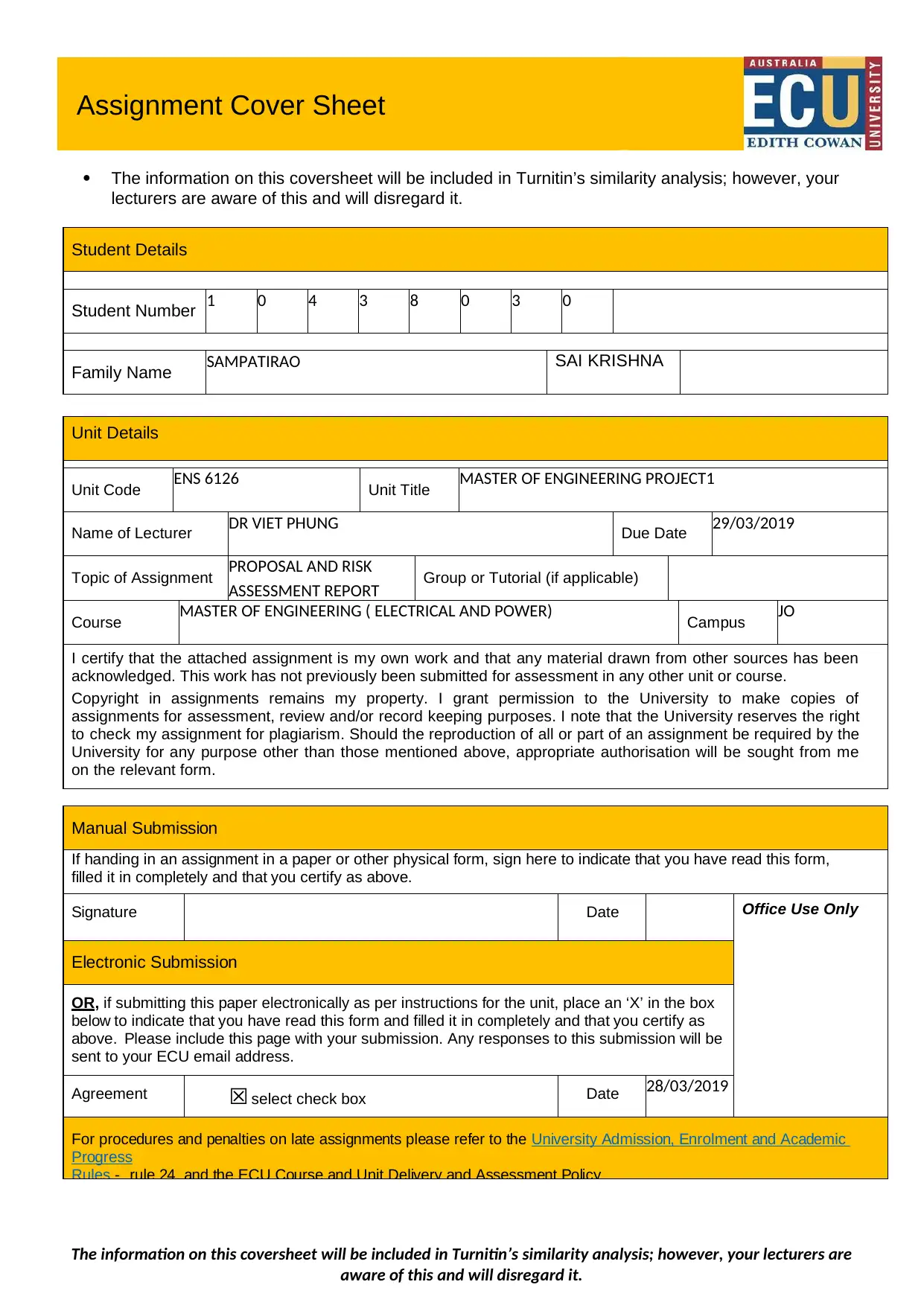
Assignment Cover Sheet
The information on this coversheet will be included in Turnitin’s similarity analysis; however, your
lecturers are aware of this and will disregard it.
Student Details
Student Number 1 0 4 3 8 0 3 0
Family Name SAMPATIRAO SAI KRISHNA
Unit Details
Unit Code ENS 6126 Unit Title MASTER OF ENGINEERING PROJECT1
Name of Lecturer DR VIET PHUNG Due Date 29/03/2019
Topic of Assignment PROPOSAL AND RISK
ASSESSMENT REPORT Group or Tutorial (if applicable)
Course MASTER OF ENGINEERING ( ELECTRICAL AND POWER) Campus JO
I certify that the attached assignment is my own work and that any material drawn from other sources has been
acknowledged. This work has not previously been submitted for assessment in any other unit or course.
Copyright in assignments remains my property. I grant permission to the University to make copies of
assignments for assessment, review and/or record keeping purposes. I note that the University reserves the right
to check my assignment for plagiarism. Should the reproduction of all or part of an assignment be required by the
University for any purpose other than those mentioned above, appropriate authorisation will be sought from me
on the relevant form.
Manual Submission
If handing in an assignment in a paper or other physical form, sign here to indicate that you have read this form,
filled it in completely and that you certify as above.
Signature Date Office Use Only
Electronic Submission
OR, if submitting this paper electronically as per instructions for the unit, place an ‘X’ in the box
below to indicate that you have read this form and filled it in completely and that you certify as
above. Please include this page with your submission. Any responses to this submission will be
sent to your ECU email address.
Agreement ☒ select check box Date 28/03/2019
For procedures and penalties on late assignments please refer to the University Ad m issi on, En r ol ment and Academic
Progress
Rules - rule 24, and the ECU Course and Unit Delivery and Assessment Policy
The information on this coversheet will be included in Turnitin’s similarity analysis; however, your lecturers are
aware of this and will disregard it.
The information on this coversheet will be included in Turnitin’s similarity analysis; however, your
lecturers are aware of this and will disregard it.
Student Details
Student Number 1 0 4 3 8 0 3 0
Family Name SAMPATIRAO SAI KRISHNA
Unit Details
Unit Code ENS 6126 Unit Title MASTER OF ENGINEERING PROJECT1
Name of Lecturer DR VIET PHUNG Due Date 29/03/2019
Topic of Assignment PROPOSAL AND RISK
ASSESSMENT REPORT Group or Tutorial (if applicable)
Course MASTER OF ENGINEERING ( ELECTRICAL AND POWER) Campus JO
I certify that the attached assignment is my own work and that any material drawn from other sources has been
acknowledged. This work has not previously been submitted for assessment in any other unit or course.
Copyright in assignments remains my property. I grant permission to the University to make copies of
assignments for assessment, review and/or record keeping purposes. I note that the University reserves the right
to check my assignment for plagiarism. Should the reproduction of all or part of an assignment be required by the
University for any purpose other than those mentioned above, appropriate authorisation will be sought from me
on the relevant form.
Manual Submission
If handing in an assignment in a paper or other physical form, sign here to indicate that you have read this form,
filled it in completely and that you certify as above.
Signature Date Office Use Only
Electronic Submission
OR, if submitting this paper electronically as per instructions for the unit, place an ‘X’ in the box
below to indicate that you have read this form and filled it in completely and that you certify as
above. Please include this page with your submission. Any responses to this submission will be
sent to your ECU email address.
Agreement ☒ select check box Date 28/03/2019
For procedures and penalties on late assignments please refer to the University Ad m issi on, En r ol ment and Academic
Progress
Rules - rule 24, and the ECU Course and Unit Delivery and Assessment Policy
The information on this coversheet will be included in Turnitin’s similarity analysis; however, your lecturers are
aware of this and will disregard it.
Paraphrase This Document
Need a fresh take? Get an instant paraphrase of this document with our AI Paraphraser

ENS6126 Master of Engineering Project 1
Progress Report
Position Tracking Of an Athlete Using IMU, Magneto Meter (GPS) and
UWB
Sai Krishna SAMPATIRAO
Student # 10438030
29 Mar 2019
Supervisor: Dr Viet Phung
Progress Report
Position Tracking Of an Athlete Using IMU, Magneto Meter (GPS) and
UWB
Sai Krishna SAMPATIRAO
Student # 10438030
29 Mar 2019
Supervisor: Dr Viet Phung
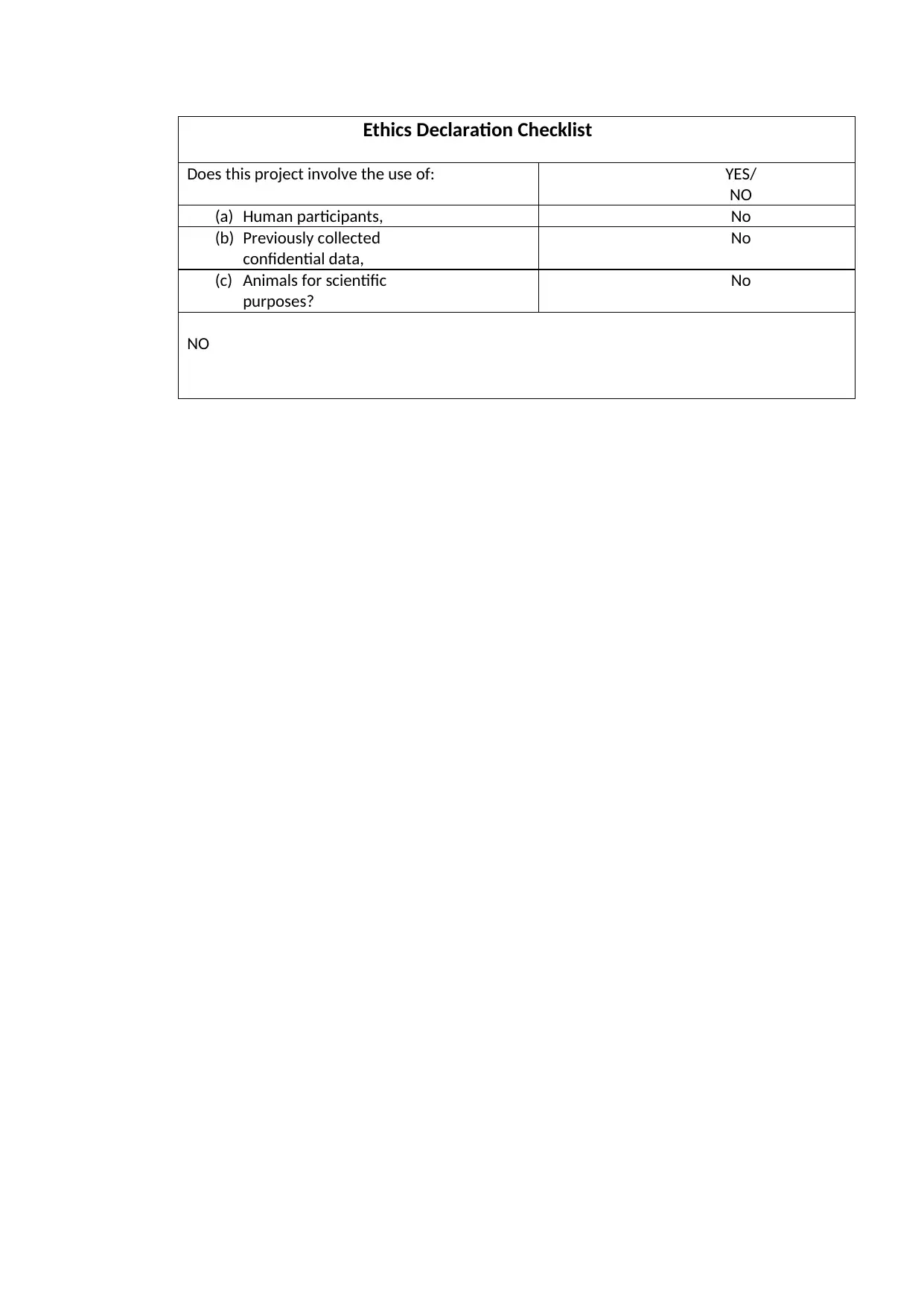
Ethics Declaration Checklist
Does this project involve the use of: YES/
NO
(a) Human participants, No
(b) Previously collected
confidential data,
No
(c) Animals for scientific
purposes?
No
NO
Does this project involve the use of: YES/
NO
(a) Human participants, No
(b) Previously collected
confidential data,
No
(c) Animals for scientific
purposes?
No
NO
⊘ This is a preview!⊘
Do you want full access?
Subscribe today to unlock all pages.

Trusted by 1+ million students worldwide
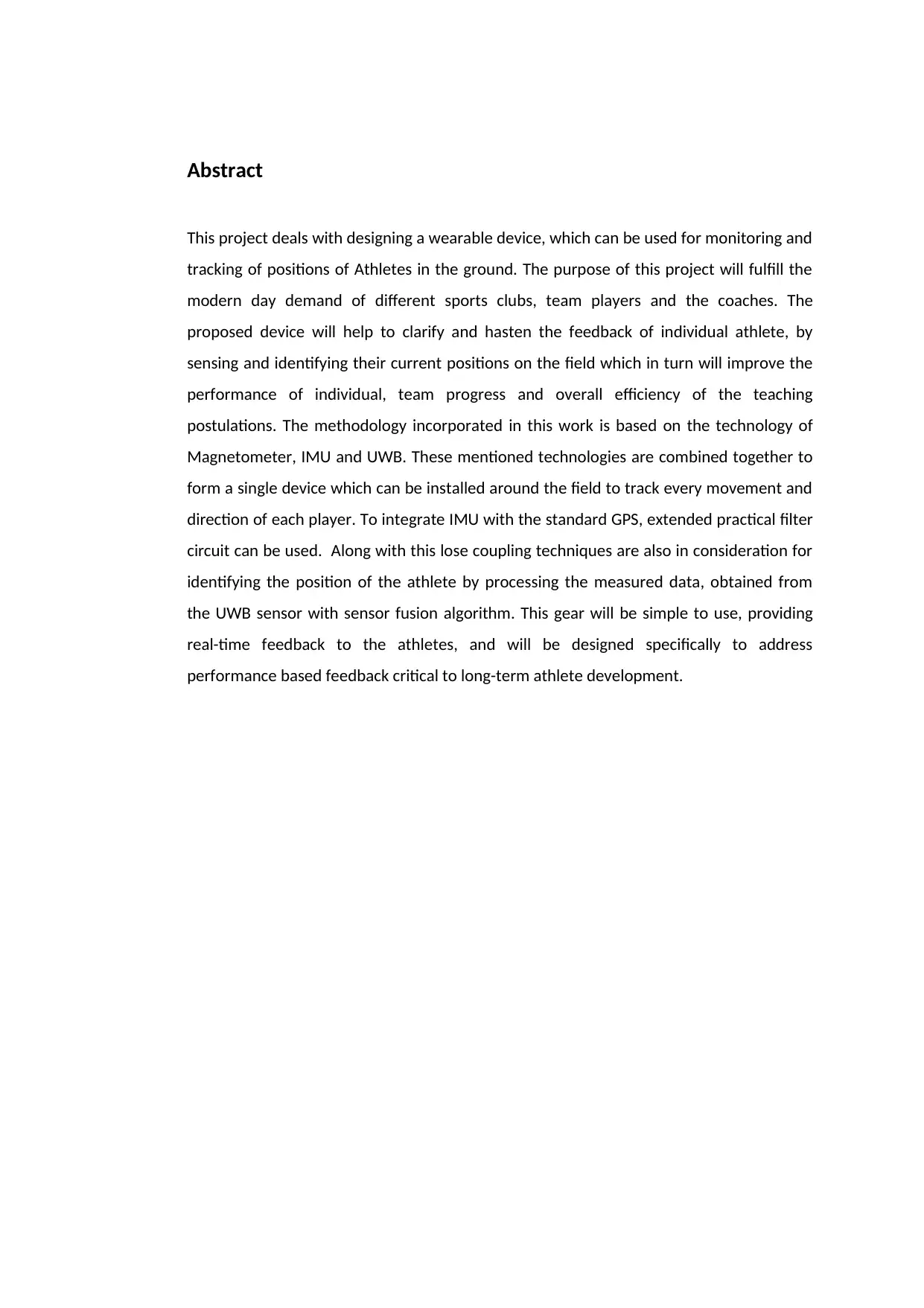
Abstract
This project deals with designing a wearable device, which can be used for monitoring and
tracking of positions of Athletes in the ground. The purpose of this project will fulfill the
modern day demand of different sports clubs, team players and the coaches. The
proposed device will help to clarify and hasten the feedback of individual athlete, by
sensing and identifying their current positions on the field which in turn will improve the
performance of individual, team progress and overall efficiency of the teaching
postulations. The methodology incorporated in this work is based on the technology of
Magnetometer, IMU and UWB. These mentioned technologies are combined together to
form a single device which can be installed around the field to track every movement and
direction of each player. To integrate IMU with the standard GPS, extended practical filter
circuit can be used. Along with this lose coupling techniques are also in consideration for
identifying the position of the athlete by processing the measured data, obtained from
the UWB sensor with sensor fusion algorithm. This gear will be simple to use, providing
real-time feedback to the athletes, and will be designed specifically to address
performance based feedback critical to long-term athlete development.
This project deals with designing a wearable device, which can be used for monitoring and
tracking of positions of Athletes in the ground. The purpose of this project will fulfill the
modern day demand of different sports clubs, team players and the coaches. The
proposed device will help to clarify and hasten the feedback of individual athlete, by
sensing and identifying their current positions on the field which in turn will improve the
performance of individual, team progress and overall efficiency of the teaching
postulations. The methodology incorporated in this work is based on the technology of
Magnetometer, IMU and UWB. These mentioned technologies are combined together to
form a single device which can be installed around the field to track every movement and
direction of each player. To integrate IMU with the standard GPS, extended practical filter
circuit can be used. Along with this lose coupling techniques are also in consideration for
identifying the position of the athlete by processing the measured data, obtained from
the UWB sensor with sensor fusion algorithm. This gear will be simple to use, providing
real-time feedback to the athletes, and will be designed specifically to address
performance based feedback critical to long-term athlete development.
Paraphrase This Document
Need a fresh take? Get an instant paraphrase of this document with our AI Paraphraser
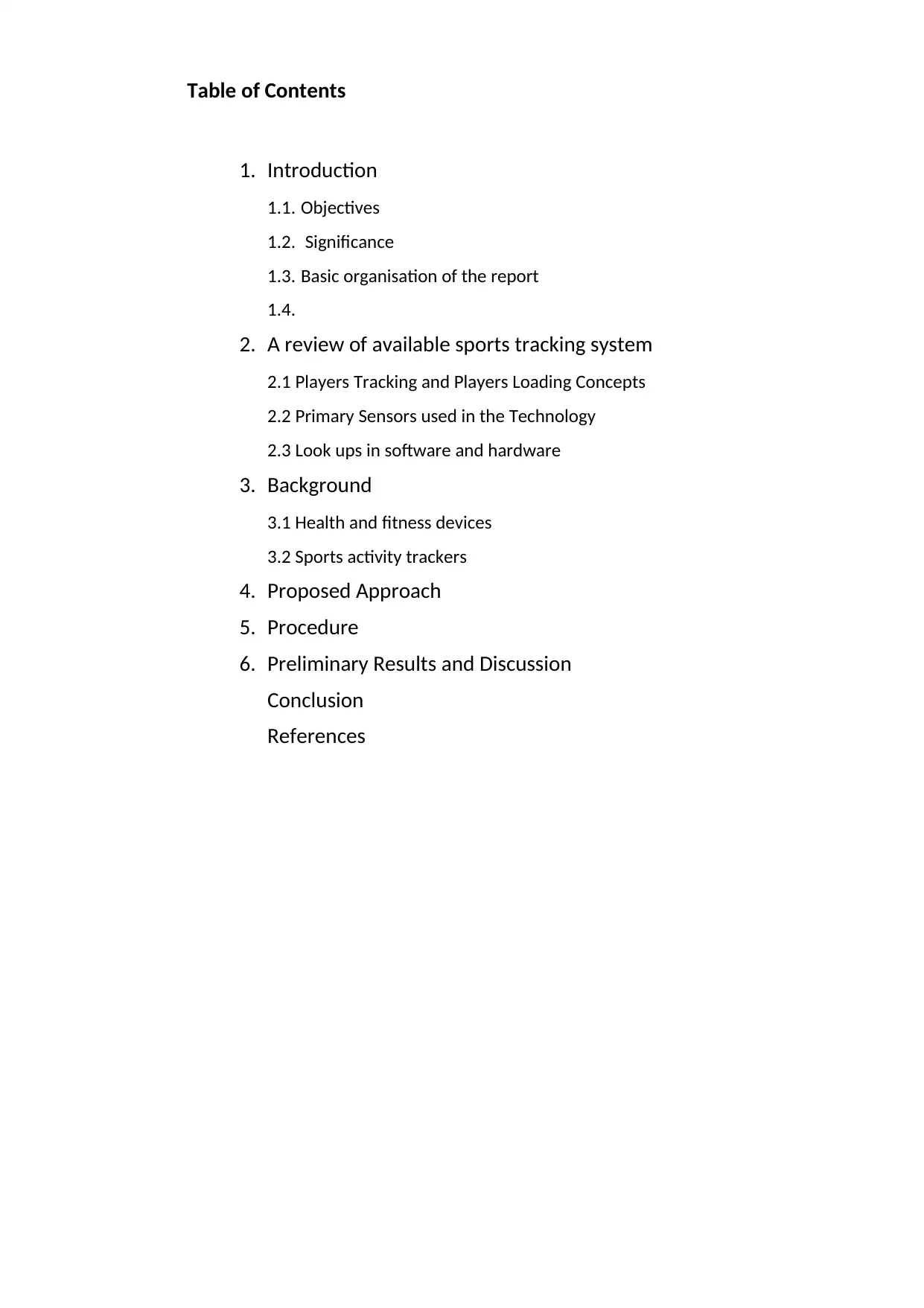
Table of Contents
1. Introduction
1.1. Objectives
1.2. Significance
1.3. Basic organisation of the report
1.4.
2. A review of available sports tracking system
2.1 Players Tracking and Players Loading Concepts
2.2 Primary Sensors used in the Technology
2.3 Look ups in software and hardware
3. Background
3.1 Health and fitness devices
3.2 Sports activity trackers
4. Proposed Approach
5. Procedure
6. Preliminary Results and Discussion
Conclusion
References
1. Introduction
1.1. Objectives
1.2. Significance
1.3. Basic organisation of the report
1.4.
2. A review of available sports tracking system
2.1 Players Tracking and Players Loading Concepts
2.2 Primary Sensors used in the Technology
2.3 Look ups in software and hardware
3. Background
3.1 Health and fitness devices
3.2 Sports activity trackers
4. Proposed Approach
5. Procedure
6. Preliminary Results and Discussion
Conclusion
References
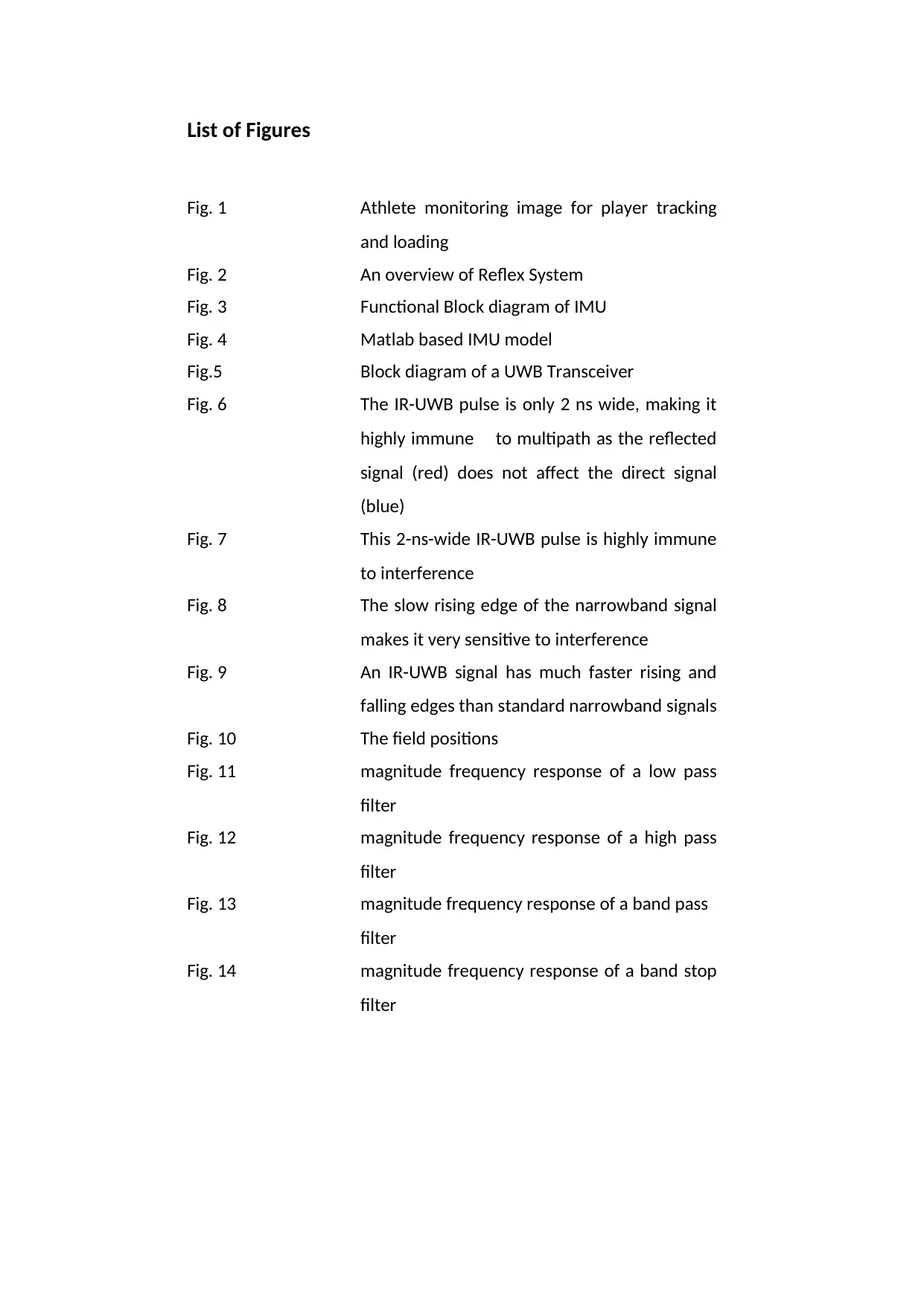
List of Figures
Fig. 1 Athlete monitoring image for player tracking
and loading
Fig. 2 An overview of Reflex System
Fig. 3 Functional Block diagram of IMU
Fig. 4 Matlab based IMU model
Fig.5 Block diagram of a UWB Transceiver
Fig. 6 The IR-UWB pulse is only 2 ns wide, making it
highly immune to multipath as the reflected
signal (red) does not affect the direct signal
(blue)
Fig. 7 This 2-ns-wide IR-UWB pulse is highly immune
to interference
Fig. 8 The slow rising edge of the narrowband signal
makes it very sensitive to interference
Fig. 9 An IR-UWB signal has much faster rising and
falling edges than standard narrowband signals
Fig. 10 The field positions
Fig. 11 magnitude frequency response of a low pass
filter
Fig. 12 magnitude frequency response of a high pass
filter
Fig. 13 magnitude frequency response of a band pass
filter
Fig. 14 magnitude frequency response of a band stop
filter
Fig. 1 Athlete monitoring image for player tracking
and loading
Fig. 2 An overview of Reflex System
Fig. 3 Functional Block diagram of IMU
Fig. 4 Matlab based IMU model
Fig.5 Block diagram of a UWB Transceiver
Fig. 6 The IR-UWB pulse is only 2 ns wide, making it
highly immune to multipath as the reflected
signal (red) does not affect the direct signal
(blue)
Fig. 7 This 2-ns-wide IR-UWB pulse is highly immune
to interference
Fig. 8 The slow rising edge of the narrowband signal
makes it very sensitive to interference
Fig. 9 An IR-UWB signal has much faster rising and
falling edges than standard narrowband signals
Fig. 10 The field positions
Fig. 11 magnitude frequency response of a low pass
filter
Fig. 12 magnitude frequency response of a high pass
filter
Fig. 13 magnitude frequency response of a band pass
filter
Fig. 14 magnitude frequency response of a band stop
filter
⊘ This is a preview!⊘
Do you want full access?
Subscribe today to unlock all pages.

Trusted by 1+ million students worldwide

List of Tables
Table 1 The list of heights the anchors are present
around the field
Table 2 The reference values of Left position of the field
player
Table 3 The measured UWB values of Left position of
the field player
Table 4 The calculated speed, distance and
Table 1 The list of heights the anchors are present
around the field
Table 2 The reference values of Left position of the field
player
Table 3 The measured UWB values of Left position of
the field player
Table 4 The calculated speed, distance and
Paraphrase This Document
Need a fresh take? Get an instant paraphrase of this document with our AI Paraphraser

1. Introduction
In the modern day of sporting and gaming it is not only about an individual’s hard
working which flourishes a player’s performance but technology also holds an
equally important position which enhances the tips and tactics for the athletes in
their respective fields. Keeping these benefits in view the technology based
devices are growing more popular among the coaches and players. With the
increasing demand of the wearable sensors, the modern day’s researcher and
industries are expressing their interest and investing time and money in this field.
1.1. Objectives
As already discussed there is a huge potential in the market for an efficient and
improved wearable device that helps in accurate tracking of players both on the
field and off the field as well (Halson, Peake & Sullivan, 2016). Hence there is a
requirement for a wearable device that is not only accurate but at the same time
less complicate and also easy to use because at the field and while players are in
training of the field, coaches are less interested in technical complexity but
demand superior performance from the device (Bailon et al., 2018). Hence the
objectives of this project is not to make things technically complicated, but to
increase efficiency and reliability so that the devices are easy to used even if the
person is not technically highly advanced (James, Lee & Wheeler, 2019). Hence
some of the important objectives of the project are:
• To design an affordable wearable devices for tracking athletes.
• Maintain high quality and ensure accuracy in the performance
• Design in such a way that it will monitor player performance so that we can
avoid injuries and aim extreme fitness levels of players.
• Ensure high ethical standard for the project with adherence to the ethical
code of standard for conducting research for the project.
1.2. Significance
Application of tracking device is not a new concept in the sport. Sport
professionals such as players, coaches are applying these technologies to analyse
performance of the players so that it is easier for them to identify issues and plan
accordingly to design strategy for improving those issues. GPS has been one of the
standard technology that is being used for years for tracking players. Although GPS
In the modern day of sporting and gaming it is not only about an individual’s hard
working which flourishes a player’s performance but technology also holds an
equally important position which enhances the tips and tactics for the athletes in
their respective fields. Keeping these benefits in view the technology based
devices are growing more popular among the coaches and players. With the
increasing demand of the wearable sensors, the modern day’s researcher and
industries are expressing their interest and investing time and money in this field.
1.1. Objectives
As already discussed there is a huge potential in the market for an efficient and
improved wearable device that helps in accurate tracking of players both on the
field and off the field as well (Halson, Peake & Sullivan, 2016). Hence there is a
requirement for a wearable device that is not only accurate but at the same time
less complicate and also easy to use because at the field and while players are in
training of the field, coaches are less interested in technical complexity but
demand superior performance from the device (Bailon et al., 2018). Hence the
objectives of this project is not to make things technically complicated, but to
increase efficiency and reliability so that the devices are easy to used even if the
person is not technically highly advanced (James, Lee & Wheeler, 2019). Hence
some of the important objectives of the project are:
• To design an affordable wearable devices for tracking athletes.
• Maintain high quality and ensure accuracy in the performance
• Design in such a way that it will monitor player performance so that we can
avoid injuries and aim extreme fitness levels of players.
• Ensure high ethical standard for the project with adherence to the ethical
code of standard for conducting research for the project.
1.2. Significance
Application of tracking device is not a new concept in the sport. Sport
professionals such as players, coaches are applying these technologies to analyse
performance of the players so that it is easier for them to identify issues and plan
accordingly to design strategy for improving those issues. GPS has been one of the
standard technology that is being used for years for tracking players. Although GPS
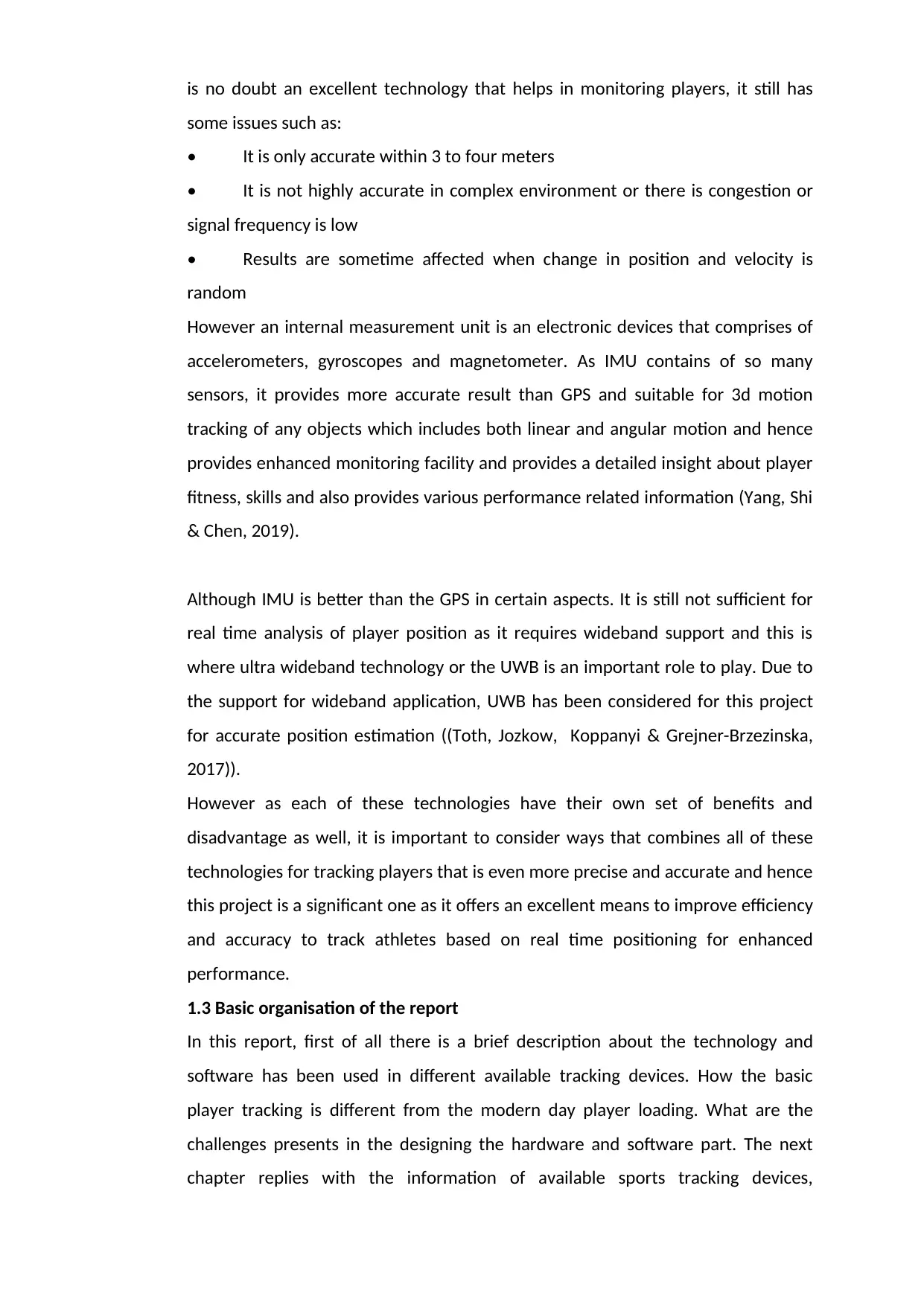
is no doubt an excellent technology that helps in monitoring players, it still has
some issues such as:
• It is only accurate within 3 to four meters
• It is not highly accurate in complex environment or there is congestion or
signal frequency is low
• Results are sometime affected when change in position and velocity is
random
However an internal measurement unit is an electronic devices that comprises of
accelerometers, gyroscopes and magnetometer. As IMU contains of so many
sensors, it provides more accurate result than GPS and suitable for 3d motion
tracking of any objects which includes both linear and angular motion and hence
provides enhanced monitoring facility and provides a detailed insight about player
fitness, skills and also provides various performance related information (Yang, Shi
& Chen, 2019).
Although IMU is better than the GPS in certain aspects. It is still not sufficient for
real time analysis of player position as it requires wideband support and this is
where ultra wideband technology or the UWB is an important role to play. Due to
the support for wideband application, UWB has been considered for this project
for accurate position estimation ((Toth, Jozkow, Koppanyi & Grejner-Brzezinska,
2017)).
However as each of these technologies have their own set of benefits and
disadvantage as well, it is important to consider ways that combines all of these
technologies for tracking players that is even more precise and accurate and hence
this project is a significant one as it offers an excellent means to improve efficiency
and accuracy to track athletes based on real time positioning for enhanced
performance.
1.3 Basic organisation of the report
In this report, first of all there is a brief description about the technology and
software has been used in different available tracking devices. How the basic
player tracking is different from the modern day player loading. What are the
challenges presents in the designing the hardware and software part. The next
chapter replies with the information of available sports tracking devices,
some issues such as:
• It is only accurate within 3 to four meters
• It is not highly accurate in complex environment or there is congestion or
signal frequency is low
• Results are sometime affected when change in position and velocity is
random
However an internal measurement unit is an electronic devices that comprises of
accelerometers, gyroscopes and magnetometer. As IMU contains of so many
sensors, it provides more accurate result than GPS and suitable for 3d motion
tracking of any objects which includes both linear and angular motion and hence
provides enhanced monitoring facility and provides a detailed insight about player
fitness, skills and also provides various performance related information (Yang, Shi
& Chen, 2019).
Although IMU is better than the GPS in certain aspects. It is still not sufficient for
real time analysis of player position as it requires wideband support and this is
where ultra wideband technology or the UWB is an important role to play. Due to
the support for wideband application, UWB has been considered for this project
for accurate position estimation ((Toth, Jozkow, Koppanyi & Grejner-Brzezinska,
2017)).
However as each of these technologies have their own set of benefits and
disadvantage as well, it is important to consider ways that combines all of these
technologies for tracking players that is even more precise and accurate and hence
this project is a significant one as it offers an excellent means to improve efficiency
and accuracy to track athletes based on real time positioning for enhanced
performance.
1.3 Basic organisation of the report
In this report, first of all there is a brief description about the technology and
software has been used in different available tracking devices. How the basic
player tracking is different from the modern day player loading. What are the
challenges presents in the designing the hardware and software part. The next
chapter replies with the information of available sports tracking devices,
⊘ This is a preview!⊘
Do you want full access?
Subscribe today to unlock all pages.

Trusted by 1+ million students worldwide

manufactured by different companies. What are the technologies used and what
features does the system provides?
In the prosed approach section, a proposed model has been explained. What are
the methods will be followed to meet the objective that has been discussed. A
clear study has been made about the technologies involved. A set of preliminary
has been attached and a comparative study has been made of the measured
parameters with the actual one.
features does the system provides?
In the prosed approach section, a proposed model has been explained. What are
the methods will be followed to meet the objective that has been discussed. A
clear study has been made about the technologies involved. A set of preliminary
has been attached and a comparative study has been made of the measured
parameters with the actual one.
Paraphrase This Document
Need a fresh take? Get an instant paraphrase of this document with our AI Paraphraser
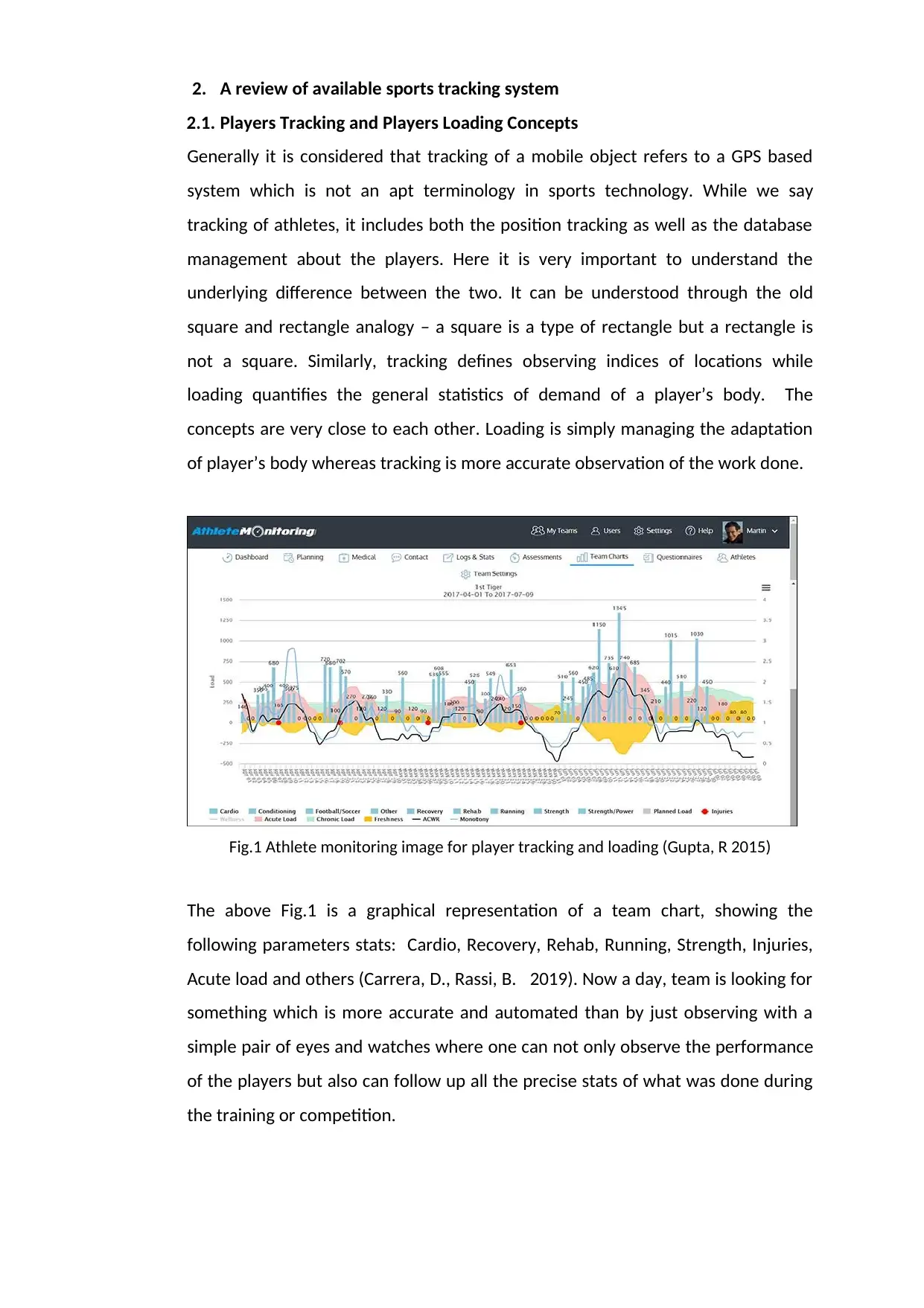
2. A review of available sports tracking system
2.1. Players Tracking and Players Loading Concepts
Generally it is considered that tracking of a mobile object refers to a GPS based
system which is not an apt terminology in sports technology. While we say
tracking of athletes, it includes both the position tracking as well as the database
management about the players. Here it is very important to understand the
underlying difference between the two. It can be understood through the old
square and rectangle analogy – a square is a type of rectangle but a rectangle is
not a square. Similarly, tracking defines observing indices of locations while
loading quantifies the general statistics of demand of a player’s body. The
concepts are very close to each other. Loading is simply managing the adaptation
of player’s body whereas tracking is more accurate observation of the work done.
Fig.1 Athlete monitoring image for player tracking and loading (Gupta, R 2015)
The above Fig.1 is a graphical representation of a team chart, showing the
following parameters stats: Cardio, Recovery, Rehab, Running, Strength, Injuries,
Acute load and others (Carrera, D., Rassi, B. 2019). Now a day, team is looking for
something which is more accurate and automated than by just observing with a
simple pair of eyes and watches where one can not only observe the performance
of the players but also can follow up all the precise stats of what was done during
the training or competition.
2.1. Players Tracking and Players Loading Concepts
Generally it is considered that tracking of a mobile object refers to a GPS based
system which is not an apt terminology in sports technology. While we say
tracking of athletes, it includes both the position tracking as well as the database
management about the players. Here it is very important to understand the
underlying difference between the two. It can be understood through the old
square and rectangle analogy – a square is a type of rectangle but a rectangle is
not a square. Similarly, tracking defines observing indices of locations while
loading quantifies the general statistics of demand of a player’s body. The
concepts are very close to each other. Loading is simply managing the adaptation
of player’s body whereas tracking is more accurate observation of the work done.
Fig.1 Athlete monitoring image for player tracking and loading (Gupta, R 2015)
The above Fig.1 is a graphical representation of a team chart, showing the
following parameters stats: Cardio, Recovery, Rehab, Running, Strength, Injuries,
Acute load and others (Carrera, D., Rassi, B. 2019). Now a day, team is looking for
something which is more accurate and automated than by just observing with a
simple pair of eyes and watches where one can not only observe the performance
of the players but also can follow up all the precise stats of what was done during
the training or competition.
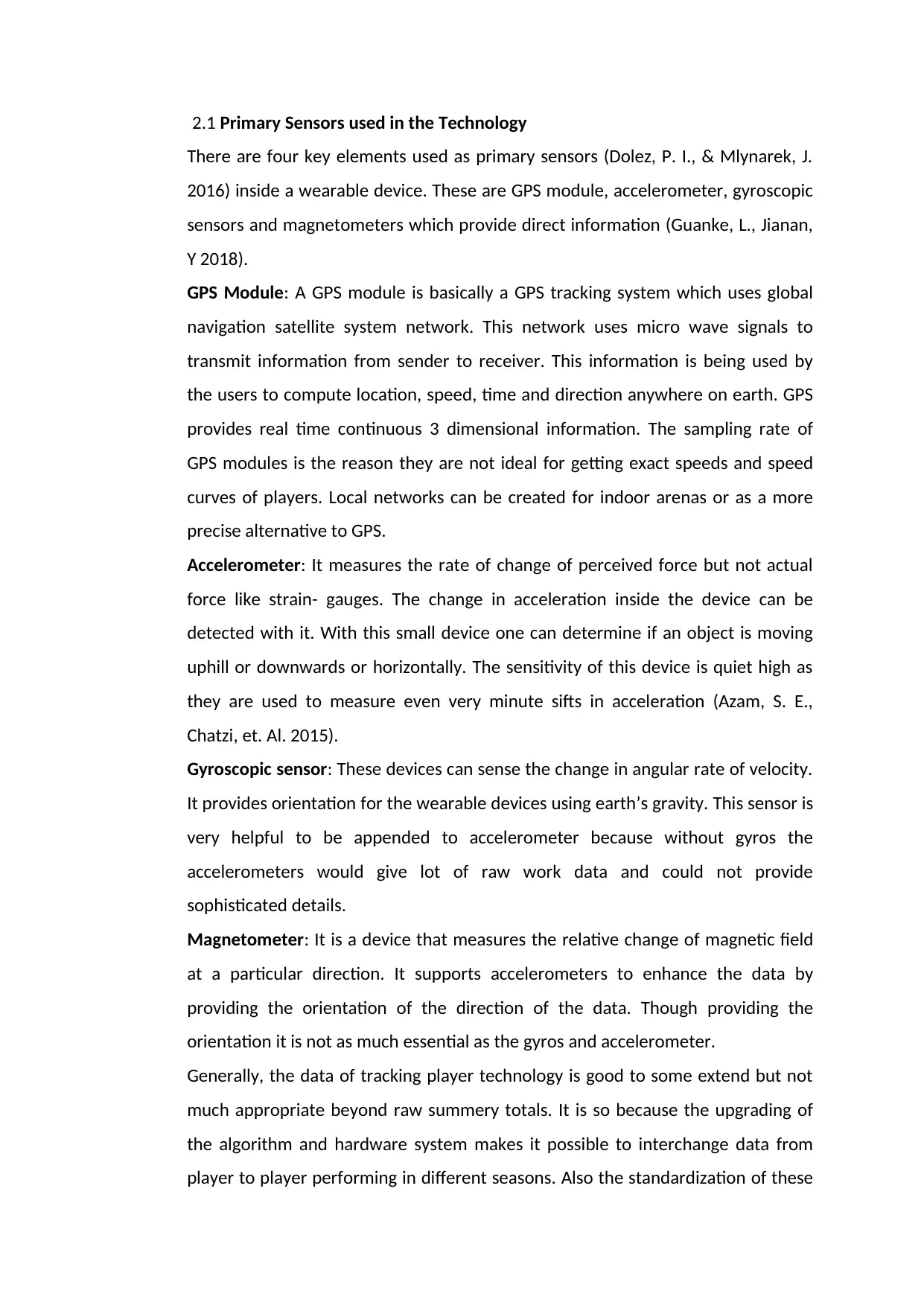
2.1 Primary Sensors used in the Technology
There are four key elements used as primary sensors (Dolez, P. I., & Mlynarek, J.
2016) inside a wearable device. These are GPS module, accelerometer, gyroscopic
sensors and magnetometers which provide direct information (Guanke, L., Jianan,
Y 2018).
GPS Module: A GPS module is basically a GPS tracking system which uses global
navigation satellite system network. This network uses micro wave signals to
transmit information from sender to receiver. This information is being used by
the users to compute location, speed, time and direction anywhere on earth. GPS
provides real time continuous 3 dimensional information. The sampling rate of
GPS modules is the reason they are not ideal for getting exact speeds and speed
curves of players. Local networks can be created for indoor arenas or as a more
precise alternative to GPS.
Accelerometer: It measures the rate of change of perceived force but not actual
force like strain- gauges. The change in acceleration inside the device can be
detected with it. With this small device one can determine if an object is moving
uphill or downwards or horizontally. The sensitivity of this device is quiet high as
they are used to measure even very minute sifts in acceleration (Azam, S. E.,
Chatzi, et. Al. 2015).
Gyroscopic sensor: These devices can sense the change in angular rate of velocity.
It provides orientation for the wearable devices using earth’s gravity. This sensor is
very helpful to be appended to accelerometer because without gyros the
accelerometers would give lot of raw work data and could not provide
sophisticated details.
Magnetometer: It is a device that measures the relative change of magnetic field
at a particular direction. It supports accelerometers to enhance the data by
providing the orientation of the direction of the data. Though providing the
orientation it is not as much essential as the gyros and accelerometer.
Generally, the data of tracking player technology is good to some extend but not
much appropriate beyond raw summery totals. It is so because the upgrading of
the algorithm and hardware system makes it possible to interchange data from
player to player performing in different seasons. Also the standardization of these
There are four key elements used as primary sensors (Dolez, P. I., & Mlynarek, J.
2016) inside a wearable device. These are GPS module, accelerometer, gyroscopic
sensors and magnetometers which provide direct information (Guanke, L., Jianan,
Y 2018).
GPS Module: A GPS module is basically a GPS tracking system which uses global
navigation satellite system network. This network uses micro wave signals to
transmit information from sender to receiver. This information is being used by
the users to compute location, speed, time and direction anywhere on earth. GPS
provides real time continuous 3 dimensional information. The sampling rate of
GPS modules is the reason they are not ideal for getting exact speeds and speed
curves of players. Local networks can be created for indoor arenas or as a more
precise alternative to GPS.
Accelerometer: It measures the rate of change of perceived force but not actual
force like strain- gauges. The change in acceleration inside the device can be
detected with it. With this small device one can determine if an object is moving
uphill or downwards or horizontally. The sensitivity of this device is quiet high as
they are used to measure even very minute sifts in acceleration (Azam, S. E.,
Chatzi, et. Al. 2015).
Gyroscopic sensor: These devices can sense the change in angular rate of velocity.
It provides orientation for the wearable devices using earth’s gravity. This sensor is
very helpful to be appended to accelerometer because without gyros the
accelerometers would give lot of raw work data and could not provide
sophisticated details.
Magnetometer: It is a device that measures the relative change of magnetic field
at a particular direction. It supports accelerometers to enhance the data by
providing the orientation of the direction of the data. Though providing the
orientation it is not as much essential as the gyros and accelerometer.
Generally, the data of tracking player technology is good to some extend but not
much appropriate beyond raw summery totals. It is so because the upgrading of
the algorithm and hardware system makes it possible to interchange data from
player to player performing in different seasons. Also the standardization of these
⊘ This is a preview!⊘
Do you want full access?
Subscribe today to unlock all pages.

Trusted by 1+ million students worldwide
1 out of 41
Related Documents
Your All-in-One AI-Powered Toolkit for Academic Success.
+13062052269
info@desklib.com
Available 24*7 on WhatsApp / Email
![[object Object]](/_next/static/media/star-bottom.7253800d.svg)
Unlock your academic potential
Copyright © 2020–2025 A2Z Services. All Rights Reserved. Developed and managed by ZUCOL.





